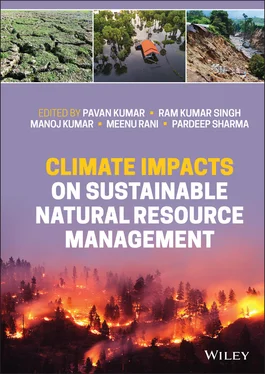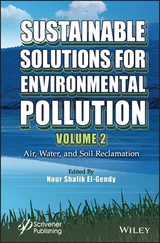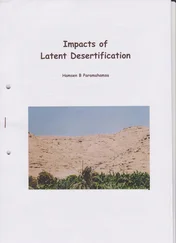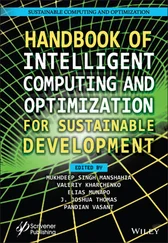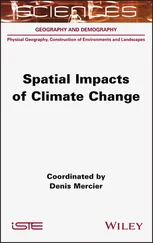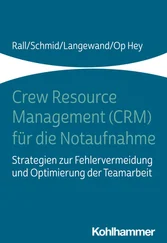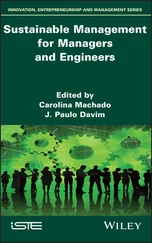Climate Impacts on Sustainable Natural Resource Management
Здесь есть возможность читать онлайн «Climate Impacts on Sustainable Natural Resource Management» — ознакомительный отрывок электронной книги совершенно бесплатно, а после прочтения отрывка купить полную версию. В некоторых случаях можно слушать аудио, скачать через торрент в формате fb2 и присутствует краткое содержание. Жанр: unrecognised, на английском языке. Описание произведения, (предисловие) а так же отзывы посетителей доступны на портале библиотеки ЛибКат.
- Название:Climate Impacts on Sustainable Natural Resource Management
- Автор:
- Жанр:
- Год:неизвестен
- ISBN:нет данных
- Рейтинг книги:4 / 5. Голосов: 1
-
Избранное:Добавить в избранное
- Отзывы:
-
Ваша оценка:
- 80
- 1
- 2
- 3
- 4
- 5
Climate Impacts on Sustainable Natural Resource Management: краткое содержание, описание и аннотация
Предлагаем к чтению аннотацию, описание, краткое содержание или предисловие (зависит от того, что написал сам автор книги «Climate Impacts on Sustainable Natural Resource Management»). Если вы не нашли необходимую информацию о книге — напишите в комментариях, мы постараемся отыскать её.
Climate Impacts on Sustainable Natural Resource Management — читать онлайн ознакомительный отрывок
Ниже представлен текст книги, разбитый по страницам. Система сохранения места последней прочитанной страницы, позволяет с удобством читать онлайн бесплатно книгу «Climate Impacts on Sustainable Natural Resource Management», без необходимости каждый раз заново искать на чём Вы остановились. Поставьте закладку, и сможете в любой момент перейти на страницу, на которой закончили чтение.
Интервал:
Закладка:
Table of Contents
1 Cover
2 Title Page
3 Copyright Page
4 About the Editors
5 List of Contributors
6 Foreword
7 Preface
8 Section 1: Sustainable Natural Resource Management 1 Impact of Local REDD+ Intervention on Greenhouse Gas Emissions in East Kalimantan Province, Indonesia 1.1 Introduction 1.2 Materials and Methods 1.3 Results 1.4 Discussion 1.5 Conclusions Acknowledgement Author Contribution List of Appendix References 2 Role of Geospatial Technologies in Natural Resource Management 2.1 Introduction 2.2 Applications of Geospatial Technology in Natural Resource Management 2.3 LiDAR Technology 2.4 Artificial Intelligence and Remote Sensing 2.5 Machine Learning Tools for Natural Resource Management 2.6 Applications of Unmanned Aerial Systems in Natural Resource Management 2.7 Google Earth Engine as a Platform for Environmental Monitoring and NRM 2.8 Conclusion References 3 Estimation of Snow Cover Area Using MicrowaveSAR Dataset 3.1 Introduction 3.2 Classification Technique 3.3 Statistical Parameters 3.4 Error and Accuracy Assessment 3.5 Study Area 3.6 Methodology 3.7 Result and Discussion 3.8 Conclusion and Future Perspective References
9 Section 2: Determinants of Forest Productivity 4 Forest Cover Change Detection Across Recent Three Decades in Persian Oak Forests Using Convolutional Neural Network 4.1 Introduction 4.2 Materials and Methods 4.3 Results and Discussion 4.4 Conclusion and Future Prospects References 5 The Interlinked Mechanisms of Productivity for Developing Process‐Based Forest Growth Models 5.1 Introduction 5.2 Productivity: Definition and Associated Components 5.3 Various Processes and Components Driving Forest Productivity 5.4 Different Approaches to Productivity Assessment 5.5 Evolution of Process‐Based Models 5.6 Conclusion References 6 Allometric Equations for the Estimation of Biomass and Carbon in the Sub‐tropical Pine Forests of India 6.1 Introduction 6.2 Chir Pine – a Boon or Bane? 6.3 Forest Carbon and Forest Biomass 6.4 Composition of Forest Biomass 6.5 Allometric Equations for Biomass Estimation 6.6 Biomass and Carbon Stock Estimation in Chir Pine Forests of India Using Allometric Equations 6.7 Conclusion References
10 Section 3: Agriculture and Climate Change 7 Characterization of Stress‐Prone Areas for Dissemination of Suitable Rice Varieties and their Adoption in Eastern India: 7.1 Introduction 7.2 Materials and Method (for Submergence‐prone: Assam) 7.3 Results and Discussion 7.4 Conclusions References 8 Farmers' Perspective and Adaptation Efforts to Tackle the Impacts of Climate Change 8.1 Introduction 8.2 Methodology 8.3 Results and Analysis 8.4 Understanding the Farmer's Perception of Climate Change 8.5 Adaptation Efforts 8.6 Conclusion References
11 Section 4: Water Resource Management and Riverine Health 9 Multicriteria Drought Severity Analysis in Monaragala District Sri Lanka by Utilizing Remote Sensing and GIS 9.1 Introduction 9.2 Methodology 9.3 Meteorological Drought of Monaragala District 9.4 Agricultural Drought of Monaragala District 9.5 Hydrological Drought of Monaragala District 9.6 Drought Risk Area Map of Monaragala District 9.7 Conclusion and Recommendations 9.8 Conclusion 9.9 Recommendation References 10 Comparative Evaluation of Predicted Hydrologic Response Under Two Extremities of Sustainability Using Transformed Landuse‐Landcover and CORDEX‐Based Climatic Scenarios 10.1 Introduction 10.2 A Brief Account of the Kangshabati River Basin, the Study Area 10.3 Data and Methodological Description 10.4 Results and Observations 10.5 Conclusion References 11 Riverine Health a Function of Riverscape Variable: A Case Study of the River Ganga in Varanasi 11.1 Introduction 11.2 Material and Methods 11.3 Result and Discussion 11.4 Conclusions References
12 Section 5: Climate Change Threat on Natural Resources 12 Socio‐Economic Impacts of Climate Change 12.1 Introduction 12.2 Trends in Climate Variables 12.3 Welfare Impact of Climate Change 12.4 Impact on Agriculture 12.5 Impact of Climate Change on Society 12.6 Conclusion References 13 The Political Economy of Vulnerable Environment in the Age of Climate Change: A Kerala Experience 13.1 Introduction 13.2 Climate Change in Kerala 13.3 Climate and Sea Level Change Projections 13.4 Natural Disasters Associated with Climate Change 13.5 The Political Economy of Climate Change and Associated Disasters 13.6 Who Are the Affected? 13.7 Conclusion and Suggestions References 14 Land Use/Land Cover (LULC) Changes in Cameron Highlands, Malaysia: Explore the Impact of the LULC Changes on Land Surface Temperature (LST)Using Remote Sensing 14.1 Introduction 14.2 Effectiveness of Usage of Satellite Imagery in Land Use/Land Cover (LULC) Change 14.3 The Impact of LULC Changes on Land Surface Temperature (LST) 14.4 Methodology 14.5 Land Use/Cover Changes in Cameron Highland from 2009 to 2019 14.6 Land Surface Temperature Analysis of Comparative Sensors between Landsat Satellite Data and MODIS 14.7 The LULC Effect on LST in Cameron Highlands 14.8 Conclusions References
13 Section 6: Linkages between Natural Resources and Biotic‐Abiotic Stressors 15 Emerging Roles of Osmoprotectants in Alleviating Abiotic Stress Response Under Changing Climatic Conditions 15.1 Introduction 15.2 Role of Osmoprotectant Under Abiotic Stress 15.3 Role of Osmoprotectants Under Drought Stress 15.4 Role of Osmoprotectants Under Salinity Stress 15.5 Role of Osmoprotectants Under Cold Stress 15.6 Role of Osmoprotectants Under Submergence Stress 15.7 Role of Osmoprotectants Under Low Light Stress 15.8 Mechanisms of Osmoprotectants Under Multiple Abiotic Stress 15.9 Approaches to Improve Osmoprotectants to Confer Abiotic Stress Tolerance 15.10 Metabolic Engineering Approach 15.11 Future Prospect for Osmoprotectants Under Changing Climatic Conditions References 16 Growth Variability of Conifers in Temperate Region of Western Himalayas 16.1 Introduction 16.2 Material and Methods 16.3 Results 16.4 Discussion 16.5 Conclusion References 17 Process‐Based Carbon Sequestration Study with Reference to the Energy‐Water‐Carbon Flux in a Forest Ecosystem 17.1 Introduction 17.2 Concept of Soil‐Vegetation‐Atmosphere‐Transfer (SVAT) 17.3 History of Flux Measurements and Recent Advances‐Different Methods 17.4 Exchange Flux Measurements over Forest Ecosystems 17.5 Ecosystem Flux Measurements Network Worldwide and Indian Scenario 17.6 State of the Current Knowledge at Forest Research Institute, Dehradun 17.7 Research Gaps and Future Needs 17.8 Conclusion References
14 Index
15 End User License Agreement
List of Tables
1 Chapter 1 Table 1.1 Land cover classes and their carbon stocks for estimating carbon... Table 1.2 Ten largest GHG emitters from land‐based sector from 2000 to 2016...
2 Chapter 3 Table 3.1 Confusion matrix for four class. Table 3.2 Cerro Laukaru, Chile SIR‐C dataset specification. Table 3.3 Unsupervised classification for Cerro Laukaru, Chile SIR‐C image. Table 3.4 SAR statistical parameter for unsupervised classification of Cerro... Table 3.5 Class population of supervised classification for Cerro Laukaru, C... Table 3.6 Confusion matrix of Wishart supervised classification for Cerro La... Table 3.7 Confusion matrix of SVM classification for Cerro Laukaru, Chile SI...Table 3.8 Class population of Wishart classification with respective class f...Table 3.9 Class population of SVM classification with respective class for C...Table 3.10 Error and accuracy assessment of Wishart supervised classificatio...Table 3.11 Error and accuracy assessment of SVM supervised classification f...
3 Chapter 4Table 4.1 Change matrix of land use classes (area in hectares) during 1980–2...
4 Chapter 5Table 5.1 Approaches for estimating forest productivity.
5 Chapter 6Table 6.1 Taxonomic classification of Pinus roxburghii .Table 6.2 Various methods for vegetation carbon estimation using inventory‐b...Table 6.3 Equations and default values used in various biomass and carbon es...
Читать дальшеИнтервал:
Закладка:
Похожие книги на «Climate Impacts on Sustainable Natural Resource Management»
Представляем Вашему вниманию похожие книги на «Climate Impacts on Sustainable Natural Resource Management» списком для выбора. Мы отобрали схожую по названию и смыслу литературу в надежде предоставить читателям больше вариантов отыскать новые, интересные, ещё непрочитанные произведения.
Обсуждение, отзывы о книге «Climate Impacts on Sustainable Natural Resource Management» и просто собственные мнения читателей. Оставьте ваши комментарии, напишите, что Вы думаете о произведении, его смысле или главных героях. Укажите что конкретно понравилось, а что нет, и почему Вы так считаете.
